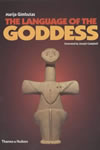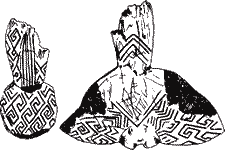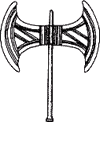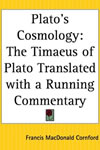The fifth and penultimate essay is called The Symbol Without Meaning. Campbell first discusses the impact of modern science. He begins with Bertrand Russell’s jibe that ‘all Americans believe that the world was created in 1492 and redeemed in 1776.’ He points out that well into the 19 th century most European Christians believed that the world was created in about 4004 B.C. and redeemed in the first century A.D. Barely two hundred years before Columbus’s tiny vessels set sail, Thomas Aquinas had argued that the Garden of Eden was an earthly place, yet to be discovered. The Venerable Bede had suggested over five centuries earlier, however, that ‘paradise could not be a corporeal place but must be entirely spiritual’. Aquinas supported St Augustine’s view, that paradise is both corporeal and spiritual.
Columbus himself believed the earth to be either pear shaped, with a stalk, or like a woman’s breast, with a nipple. He believed that he was sailing downhill when he journeyed north, and that the Orinoco was one of the four rivers of paradise at the stalk end of the pear. Within decades subsequent explorers were able to rebut this supposition. Copernicus returned to an earlier Greek notion of the position of the earth in the solar scheme. Kepler and Galileo offered proofs that demonstrated the value of this hypothesis. Campbell cites the Papal Inquisition’s infamous condemnation of Galileo: ‘The proposition that the sun is in the center of the world and immovable from its place is absured, philosophically false, and formally heretical; because it is expressly contrary to Holy Scriptures.’ So Galileo was deemed guilty of heresy. And this is not just a Roman Catholic blindness, Luther too ‘brayed at Copernicus, naming him “an ass who wants to pervert the whole of art of astronomy and deny what is said in the book of Joshua, only to make a show of his ingenuity and attract attention.”’
Within three centuries, even the sun was no longer at the centre of the universe. A universe that had expanded from the few thousand miles sailed by Columbus to billions of light years; exploding ever outward and spinning about its centre over hundreds of millions of years, not simply the few thousand held true by the Pope’s Inquisitors.
Campbell now poses the simple question that has divided so many from religious belief: ‘How, in the way of reason, is any mind confronted with this new image of the universe to understand, interpret, evaluate, or make any use whatsoever of the mythological cosmology of Holy Writ — or of any other of the many archaic traditions still asserting their superstitious claims in the modern world?’
He turns to the confirmation in the Credo of Pope Paul VI, as recently as June 1968, of the dogma of the Assumption of the Virgin Mary, according to which the mother of Jesus did not die but was ‘raised body and soul to heavenly glory’. Campbell does not mince words: ‘The image is ridiculous’. Even travelling at the speed of light, he points out, she would only have travelled 2,000 light years thus far, so would not yet have left our own galaxy in her ascent to heaven. Such doctrines, in whatever tradition, have always ‘guaranteed to their believers a spiritual superiority over the other peoples of the earth — and we may well ask whether in our world today there is still room for such dangerous nonsense’.
The first potential answer is that myths give us psychological and sociological insight into their cultures. Even if they are taken as an art form, rather than a repository of wisdom. Here Campbell takes a significant detour to explain Jung’s differentiation between a sign — seen as a ‘reference to some concept or object, definitely known’ — and a symbol: ‘the best possible figure by which allusion may be made to something relatively unknown’. Such a differentiation is also found in classical Indian philosophy: the term paroksa means that which is ‘beyond the reach of the eye’, and can be equated to Jung’s ‘symbol’. And here is an important difference between occident and orient: such paroksa symbols are seen to belong to the angelic, divine or dream world, to be of a subtle matter; where in the West all things are brought into the quantitative world of matter — the waking world. So, as Campbell points out ‘the findings of modern science do not as greatly trouble Hinduism and Buddhism as they trouble Christianity and Judaism, where all the symbols have been taught and read as signs.’ In the occident, heaven and earth are being torn apart by intellectual thought, in the orient such a division is unnecessary. This age old recognition of the psychological weight of the dream world gives myths a deeper significance and a greater usefulness in the eastern tradition. Rather than arguing the historical adequacy of metaphors — as westerners still do — orientals can probe the actual meanings of their mythology. To comprehend this significance, Campbell journeys back to the beginnings of agriculture and stock breeding in the Near East in about 9000 B.C.
Hunting tribes began to supplement their diet by harvesting grain from grasses. Settlements began to develop, and protective walls were erected. Before pottery was made — from between 6500-5500 B.C., there are signs of a skull cult — where human skulls are found in houses, suggesting the veneration of ancestors. These skulls have been found in various locations distant from one another set up in the same way, and lightly covered with plaster, the eyes inset with shells. Bull cults later abound, and the moon bull is symbolic of resurrection in a variety of later cultures — the moon bull being both the child and the consort of the cosmic goddess. In this way, archeology evinces the persistence of fundamental ideas for thousands of years in human cultures.
Both planting and stock breeding spread outward, across the globe, taking with them certain beliefs set into mythology. The fertile crescent — modern Iraq — stayed at the centre of cultural development for millenia. New art forms were consistently generated. By these early societies, we catch glimpses of a structure fundamental to our own culture, formerly hidden. For example, the strict pattern upon which Christian cathedrals are built — the placing of the apse, the nave and their images — seem to have parallels from the earliest times in the paleolithic cave art made between 30,000 and 9,000 B.C. — long predating even Sumer.
Among hunters, by the age of twelve a boy ‘is a more or less competent master of the entire technological inheritance of his culture’, and so self-reliant. With the development of agriculture and stock breeding this is no longer the case, and as Campbell points out ‘the problem of existing as a mere fraction instead of as a whole imposes certain stresses on the psyche which no primitive hunter ever had to endure’. For this reason, the symbols of the two cultures differ. These two systems of symbols persist globally in the two different forms of society. Our species originated in homo erectus some two million years ago, and until a mere ten thousand years ago developed as a hunting species. Perhaps much of our perception of the world is still bounded in the forms developed by our agriculturist ancestors. And that economy is giving way to an industrial society throughout the world.
The first artistic forms were of the Great Mother. These persisted for thousands of years, until they were displaced by painted images of animals and male shamans. These in turn gave way to mandalas — symbolic images. Within such a design is found the second known use of the swastika. The first swastika was found on a bird figurine dating to about 10,000 B.C., discovered in the Ukraine. Maltese crosses and the double axe are also found far back. These designs persisted across thousands of miles and thousands of years.The first towns rose in Sumer in around 3500 B.C. Campbell terms this originating culture of the modern world the ‘hieratic city state’. The city ‘is conceived as an imitation on earth of the celestial order’. The king is the deity at the centre of the orderly mandala — as above, so below. The calendar was calculated, and the activities of the city regulated in accordance to predicted seasons. Ritual bound the society together; writing first appeared; as did wheeled transport. Both the sexagesimal and the decimal systems of number through which we still measure the heavens, time and the business of the earth also came into being. The 360 degrees of the circle mark the year, leaving five days as a gateway from the temporal — the holy days of feast.
From Sumer and Babylon these ideas travelled to Egypt in about 2800 B.C.; outward to Crete and the Indus Valley some 200 years later; to Shang China around 1500 B.C., and eventually to the Americas in around 1000 B.C. ‘We have, therefore, to recognise what now appears to be the demonstrated and documented fact that all of the high civilizations of the world are, finally, but so many variants and developments of a single marvelous monad of mythological inspiration.’ Our own world is built upon this foundation, from which many of our fundamental — and often unquestionable — assumptions arise. Man is being brought into order by insistent patterns handed on through the generations. These patterns are related in the myths and stories that seek to explain our relationship to the cosmos, but these explanations remain for the most part hidden, although by tradition we are compelled to follow them.
Plato asserted that our function was to align ourselves with this order in the cosmos. In Egypt the pattern was called Ma’at, in India Dharma, in China Tao. ‘The myths and rites constellate a mecocosm — a mediating, middle cosmos, through which the microcosm of the individual is brought into relation to the macrocosm of the universe. And this mecocosm is the entire context of the body social, which is thus a kind of living poem, hymn, or icon.’Campbell then hazards that this ‘soul’ can therefore be seen as an imprint rather than inherent. And with the dawn of humanism in the Renaissance, and its eventual dominance in the modern world, we see a departure from this ancient model. So a new image has been placed at the centre of the mandala. Campbell now calls a halt to return to the differences between the shaman of the hunter-gatherer society and the priest of the agricultural society.
September 2004




.jpg)
.jpg)
